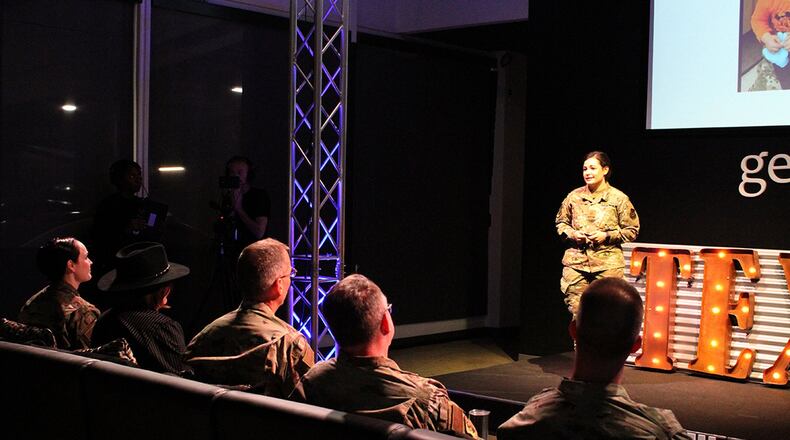Vasta came up with the idea for a mobile application or web-based platform three years ago when she had her first child. The concept, called Kinderspot, helps parents of children enrolled in military CDCs sublease their child’s spot to eligible families with short-term childcare needs. Her family’s first experience with subleasing a spot at her local CDC didn’t go smoothly. The process wasn’t standardized, and CDC users were subleasing in an ad hoc manner using Facebook sites. It just “didn’t feel right,” she said.
“There are a lot of other people out there with this problem, too, so I knew it was an enterprise problem I could solve,” Vasta said.
Last year, she began developing her idea and looking for ways to get Air Force support. An opportunity to pitch her idea at the AFIMSC Innovation Rodeo helped her get the support she was looking for, and she’s now eager to get her idea developed and fielded for military families.
“It feels amazing to win,” she said. “I’m excited to see where this can go now that it has the backing of AFIMSC. It feels awesome to be the voice of (a service) we all need.”
This second annual AFIMSC Innovation Rodeo concluded the center’s call-for-topics campaign that ran Air Force-wide Nov. 1 through Dec. 31.
“Innovation is the future. If we ever stay stuck in our ways, we can never move forward,” said Maj. Gen. Tom Wilcox, AFIMSC commander. “Innovation Rodeo reaches out to those people who have great ideas. We are able to grab those ideas and walk them all the way to reality. That’s what’s special about the AFIMSC Innovation Rodeo.”
The campaign received more than 150 submissions from around the world, from every mission support group, said Marc Vandeveer, AFIMSC chief innovation officer.
“The caliber of this year’s ideas are phenomenal,” he said. “We had 2,000 active comments and votes in our Ideascale online ideation platform. These eight teams are the best of the best.”
Throughout the week, finalists worked with leading innovators to hone their ideas and fine tune their pitches before trying to convince a panel of five senior Air Force leaders that their innovations were worth funding.
The ideas ranged from leveraging the latest technologies to make work easier, safer and more efficient to establishing programs aimed at improving quality of life for Airmen and their families.
Other Innovation Rodeo winners are:
Second Place: Augmented Reality for Utility and Communications Infrastructure, Senior Airman Tyler Strauser, 96th Communications Squadron, Eglin Air Force Base, Florida. This idea would replace the current manual mapping of underground cabling and wiring with the use of augmented reality glasses to save time and simplify processes.
Third Place: Autonomous Mowers for Airfield Mowing Operations, Jason Griffith and Byron Icenogle, 375th Civil Engineer Squadron at Scott Air Force Base, Illinois. Their innovation proposes using autonomous robotic lawn mowers to cut the grass in and around airfields at night, which would reduce aircraft bird-strike hazards.
In addition to the top three, judges surprised the teams by selecting two other ideas for further development:
Additive Manufacturing, Staff Sgt. Nate Klingbeil and Airman 1st Class Jordan Vesey, 627th Logistics Readiness Squadron at Joint Base Lewis-McChord, Washington. Their innovation uses 3D printing to create metal replacement parts for fire trucks and potentially other military fleet vehicles.
Real Property Records Software Bots, Susan Lasiter and Catherine Ward, Air Force Civil Engineer Center at Joint Base San Antonio-Lackland, Texas. In order to attain and maintain complete data for Air Force real property, the bots capability would significantly reduce the time and cost to input and retrieve data and reports.
Going forward, the AFIMSC Innovation Office will work with the winners to develop and implement an execution strategy for their ideas, Vandeveer said.
“Our team is committed. We are dedicated to getting these ideas implemented and into reality,” he said. “We’ll work the acquisition process and work with the small business and innovation research programs to find industry partners, marry them up and ensure they’re successful.”
Though only three ideas were awarded money during the rodeo, Vandeveer said the journey isn’t necessarily over for the other teams.
“We love all their submissions,” he said. “We think all eight today will move forward in some way, shape or form. We have three winners, but we’ll work with all of them.”
The AFIMSC Innovation Office stood up in late 2018 to tackle and solve complex challenges facing the Air Force installation and mission and support enterprise. Since then, the team has grown $150,000 in initial seed money to $6 million in funding through partnerships with leading innovation hubs, including AFWERX and the Air Force Small Business Innovation Research Program.
Over the next four years, Vandeveer expects that number to grow to more than $40 million. Without programs like the AFIMSC Innovation Rodeo and input from Airmen, however, the office wouldn’t be able to solve the challenges facing the enterprise.
“Innovation starts at our bases,” he said. “It starts with our Airmen who are doing the mission every day. They are the ones who have these innovative ideas. It’s our job to help them, to put them into a position to move their ideas forward and benefit Airmen across the Air Force.”
About the Author
